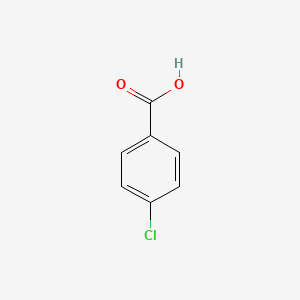



1. 4-chlorobenzoate
2. 4-chlorobenzoic Acid, Calcium(2:1) Salt
3. 4-chlorobenzoic Acid, Mercury(+1) Salt
4. 4-chlorobenzoic Acid, Mercury(+2)(2:1) Salt
5. 4-chlorobenzoic Acid, Sodium Salt
6. 4-chlorobenzoic Acid, Sodium Salt, 11c-labeled
7. Para-chlorobenzoic Acid
1. 74-11-3
2. P-chlorobenzoic Acid
3. Benzoic Acid, 4-chloro-
4. Chlorodracylic Acid
5. P-chlorbenzoic Acid
6. Benzoic Acid, P-chloro-
7. Para-chlorobenzoic Acid
8. 4-chloro-benzoic Acid
9. P-carboxychlorobenzene
10. Acido P-clorobenzoico
11. Acido P-clorobenzoico [italian]
12. Mfcd00002531
13. 4-chloro Benzoic Acid
14. Ic7888df4l
15. Chebi:30747
16. Nsc-32738
17. Ncgc00090858-02
18. Ccris 5994
19. Hsdb 6019
20. Einecs 200-805-9
21. Nsc 32738
22. Brn 0907196
23. Unii-ic7888df4l
24. Ai3-03715
25. Acemetacin Impurity A
26. Dsstox_cid_4772
27. 2-chloro-5-carboxybenzene
28. Bmse000438
29. Chembl618
30. Dsstox_rid_77525
31. Nciopen2_004782
32. Dsstox_gsid_24772
33. Schembl28384
34. 4-chlorobenzoic Acid, 99%
35. 4-09-00-00973 (beilstein Handbook Reference)
36. Mls002152923
37. Chlorobenzoic Acid, P-
38. Indomethacin Related Compound B
39. 4-chlorobenzoic Acid-[13c6]
40. Dtxsid9024772
41. Nsc8444
42. P-chlorobenzoic Acid [mi]
43. Zinc156865
44. Cs-m3680
45. Nsc-8444
46. Nsc32738
47. P-chlorobenzoic Acid [hsdb]
48. Str00110
49. Tox21_400062
50. Bdbm50405318
51. Stl164311
52. Akos000118962
53. P-chlorobenzoic Acid [who-dd]
54. Db03728
55. Ps-4074
56. Cas-74-11-3
57. Ncgc00090858-01
58. Ncgc00090858-03
59. 4-chlorobenzoic Acid, Analytical Standard
60. Smr001224523
61. Sy002326
62. Acemetacin Impurity A [ep Impurity]
63. Db-055838
64. Ft-0618183
65. Indometacin Impurity A [ep Impurity]
66. C02370
67. D77513
68. Indomethacin Related Compound B [usp-rs]
69. Ae-562/40168810
70. Q2235989
71. Sr-01000855009-2
72. W-104433
73. 4-chlorobenzoic Acid, Vetec(tm) Reagent Grade, 98%
74. F2191-0096
75. Z1258943359
76. Acemetacin Impurity A, European Pharmacopoeia (ep) Reference Standard
77. Indomethacin Related Compound B, United States Pharmacopeia (usp) Reference Standard
| Molecular Weight | 156.56 g/mol |
|---|---|
| Molecular Formula | C7H5ClO2 |
| XLogP3 | 2.7 |
| Hydrogen Bond Donor Count | 1 |
| Hydrogen Bond Acceptor Count | 2 |
| Rotatable Bond Count | 1 |
| Exact Mass | 155.9978071 g/mol |
| Monoisotopic Mass | 155.9978071 g/mol |
| Topological Polar Surface Area | 37.3 Ų |
| Heavy Atom Count | 10 |
| Formal Charge | 0 |
| Complexity | 128 |
| Isotope Atom Count | 0 |
| Defined Atom Stereocenter Count | 0 |
| Undefined Atom Stereocenter Count | 0 |
| Defined Bond Stereocenter Count | 0 |
| Undefined Bond Stereocenter Count | 0 |
| Covalently Bonded Unit Count | 1 |
P-chlorobenzoyl-beta-d-glucuronic acid in rabbit. /From table/
Goodwin, B.L. Handbook of Intermediary Metabolism of Aromatic Compounds. New York: Wiley, 1976., p. C-19
Yields p-chlorohippuric acid in man. /From table/
Goodwin, B.L. Handbook of Intermediary Metabolism of Aromatic Compounds. New York: Wiley, 1976., p. C-19
Pseudomonas sp. WR912 was isolated by continuous enrichment in three steps with 3-chloro-, 4-chloro-, and finally 3,5-dichlorobenzoate as sole source of carbon and energy. The doubling times of the pure culture with these growth substrates were 2.6, 3.3, and 5.2 h, respectively. Stoichiometric amounts of chloride were eliminated during growth. Oxygen uptake rates with chlorinated benzoates revealed low stereospecificity of the initial benzoate 1,2-dioxygenation. Dihydrodi-hydroxybenzoate dehydrogenase, catechol 1,2-dixoygenase, and muconate cycloisomerase activities were found in cell-free extracts. The ortho cleavage activity for catechols appeared to involve induction of isoenzymes with different stereospecificity towards chlorocatechols. A catabolic pathway for chlorocatechols was proposed on the basis of similarity to chlorophenoxyacetate catabolism, and cometabolism of 3,5-dimethylbenzoate by chlorobenzoate-induced cells yielded 2,5-dihydro-2,4-dimethyl-5-oxo-furan-2-acetic acid.
PMID:453823 Full text: https://www.ncbi.nlm.nih.gov/pmc/articles/PMC243232 Hartmann J et al; Appl Environ Microbiol 37 (3): 421-8 (1979)
A mixed population, enriched and established in a defined medium, from a sewage sludge inoculum was capable of complete mineralization of 4-chlorobenzoate. An organism, identified as Arthrobacter sp., was isolated from the consortium and shown to be capable of utilizing 4-chlorobenzoate as the sole carbon and energy source in pure culture. This organism (strain TM-1), dehalogenated 4-chlorobenzoate as the initial step in the degradative pathway. The product, 4-hydroxybenzoate, was further metabolized via protocatechuate. The ability of strain TM-1 to degrade 4-chlorobenzoate in liquid medium at 25 C was improved by the use of continuous culture and repeated sequential subculturing. Other chlorinated benzoates and the parent compound benzoate did not support growth of strain TM-1. An active cell extract was prepared and shown to dehalogenate 4-chloro-, 4-fluoro-, and 4-bromobenzoate. Dehalogenase activity had an optimum pH of 6.8 and an optimum temperature of 20 C and was inhibited by dissolved oxygen and stimulated by manganese (Mn). Strain improvement resulted in an increase in the specific activity of the cell extract from 0.09 to 0.85 nmol of 4-hydroxybenzoate per min per mg of protein and a decrease in the doubling time of the organism from 50 to 1.6 hr.
PMID:16346660 Full text: https://www.ncbi.nlm.nih.gov/pmc/articles/PMC241668 Marks TS et al; Appl Environ Microbiol 48 (5): 1020-5 (1984)
Octanoate, salicylate, valproic acid, p-octyl-, p-nitro-, and p-chlorobenzoic acids were effective inhibitors of benzoic acid activation to benzoyl-CoA by mitochondrial extracts. p-Aminobenzoic acid was much less effective. Of these compounds, only salicylate and p-nitrobenzoic acid were not activated to their respective CoA esters. Salicylate, p-chloro- and p-nitrobenzoic acids effectively prevented inhibition of glucose synthesis and alpha-keto[1-(14)C]isovalerate oxidation by valproic acid, p-octyl-, and p-aminobenzoic acids, p-Octyl- and p-aminobenzoic acids greatly depleted hepatocyte free CoA and acetyl-CoA contents and increased the content of acid-insoluble and acid-soluble CoA esters respectively. p-Chloro- and p-nitrobenzoic acids prevented the sequestration of CoA as p-octylbenzoyl-CoA or p-aminobenzoyl-CoA in hepatocytes incubated with these compounds. p-Chlorobenzoic acid not only prevented but also reversed the inhibition of gluconeogenesis in hepatocytes incubated with p-octylbenzoic acid. These results suggest that p-chloro- or p-nitrobenzoic acids might be effectively used to reverse some of the hepatotoxic effects of the CoA esters of valproic acid or naturally-occurring organic acids, such as those which accumulate in Reye's Syndrome or organic acidemias.
PMID:3117062 Swartzentruber MS, Harris RA; Biochem Pharmacol 36 (19): 3147-53 (1987)